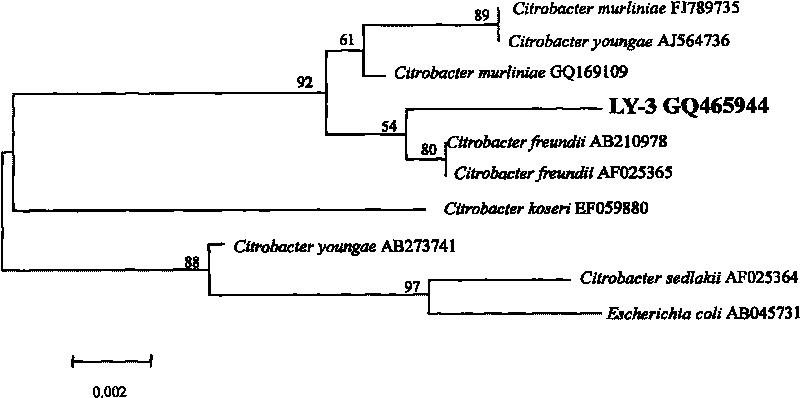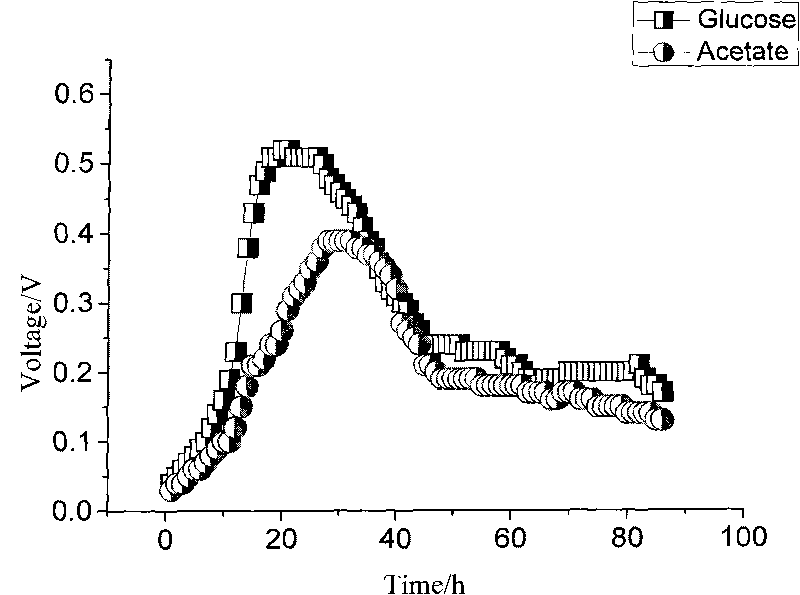Application of citrobacter freundii in electricity generation by microorganism and electricity generation method
A technology of Freund's citric acid and microbial power generation, which is applied in the field of environment and new energy, can solve the problems that the electrogenic activity of Citrobacter freundii has not been discovered, and achieve the effects of large electricity production voltage, easy cultivation, and strong adaptability
- Summary
- Abstract
- Description
- Claims
- Application Information
AI Technical Summary
Problems solved by technology
Method used
Image
Examples
Embodiment 1
[0026] Embodiment 1: the screening of bacterial strain Citrobacter freundiiLY-3 of the present invention
[0027] 1. Strain Isolation
[0028] Collect mud samples at a depth of 10cm below the surface of the dry lake bottom in South China Agricultural University (Guangzhou), and quickly transfer them to an anaerobic operation box that has reached anaerobic conditions. uniform. Take 1ml of the sample diluent and inject it into 10ml of IRM liquid medium, enrich and culture for three generations at 30°C. Then, streak on LB solid medium, culture anaerobically at 30°C for 3 days, observe the characteristics of the colonies, pick out bacteria with different colony shapes and separate them by streaking, culture for 3 generations to obtain pure strains, and store them until electrochemical investigation.
[0029] Wherein, the component of IRM medium is: NaHCO 3 2.5g / L, KCl 0.1g / L, NH 4 Cl 1.5g / L, NaH 2 PO 4 0.6g / L, NaAc 20mM, ferric citrate 20mM, yeast extract 0.5g / L.
[0030] ...
Embodiment 2
[0033] Embodiment 2: the identification of bacterial strain Citrobacter freundiiLY-3 of the present invention
[0034] The LY-3 strain obtained in Example 1 was identified by observation of morphological characteristics, physiological and biochemical assays, and 16S rDNA gene sequence analysis.
[0035] 1. Observation of Morphological Characteristics
[0036] The surface of the LY-3 strain colony is smooth, translucent, with neat edges and glossy surface.
[0037] 2. Physiological and biochemical assays
[0038] The physiological and biochemical properties of strain LY-3 are compared with those of Citrobacter species in the "Common Bacteria System Identification Manual" as shown in Table 1.
[0039] Table 1 Comparison of physiological and biochemical properties of strain LY-3 and Citrobacter freundii
[0040]
[0041]
[0042] Note: +: positive; -: negative; ND: not tested; d: different
[0043] 3.16S rDNA Phylogenetic Analysis
[0044] The whole gene of LY-3 was ex...
Embodiment 3
[0049] Example 3: Investigation of the electricity production of the strain Citrobacter freundii LY-3 of the present invention using glucose as fuel
[0050] In this example, a microbial fuel cell using LY-3 to generate electricity is constructed according to the prior art and methods. The microbial fuel cell uses two chambers, including an anode chamber and a cathode chamber, an exchange membrane and an external circuit. The electrode material is carbon felt, and the connection external resistance is 1000Ω.
[0051] The electricity generation principle of MFC is: organic matter is oxidized by Citrobacter freundii as fuel in the anaerobic anode chamber to generate electrons and protons, among which electrons are captured by Citrobacter freundii and transferred to the anode of the battery, and the electrons arrive through the external circuit The cathode, thus forming a circuit to generate current, and the protons pass through the exchange membrane to the cathode, where they re...
PUM
 Login to View More
Login to View More Abstract
Description
Claims
Application Information
 Login to View More
Login to View More - R&D
- Intellectual Property
- Life Sciences
- Materials
- Tech Scout
- Unparalleled Data Quality
- Higher Quality Content
- 60% Fewer Hallucinations
Browse by: Latest US Patents, China's latest patents, Technical Efficacy Thesaurus, Application Domain, Technology Topic, Popular Technical Reports.
© 2025 PatSnap. All rights reserved.Legal|Privacy policy|Modern Slavery Act Transparency Statement|Sitemap|About US| Contact US: help@patsnap.com



